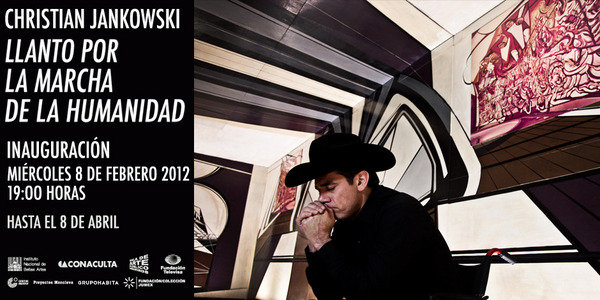Christian Jankowski and Guga Ferraz
dal 7/2/2012 al 7/4/2012
Segnalato da
Sala de Arte Publico Siqueiros
7/2/2012
Christian Jankowski and Guga Ferraz
Sala de Arte Publico Siqueiros, Mexico City
With 'Crying for the March of Humanity' Jankowski addresses the power of Televisa - one of the largest Spanish-language broadcast companies - through the deconstruction of the dramatic gestures that mediate between fiction and reality. With 'Dormitory City', Ferraz created a resting space for the more than fourteen thousand homeless people that live in Mexico City, but do not have a decent space to sleep.

The Sala de Arte Público Siqueiros (SAPS) announces the opening of two new exhibitions: Crying for the March of Humanity by German artist Christian Jankowski, and Cidade Dormitório (Dormitory City) by Guga Ferraz. The latter marks the culmination of the collaboration between the SAPS and the Brazilian institution A Gentil Carioca, entitled A Wall with Kindness.
With the work of Christian Jankowski, Crying for the March of Humanity presents an innovative and complex analysis of the relationship between art and politics, a discourse that the SAPS has been dedicated to for the last three years. Jankowski addresses the power of Televisa—one of the largest Spanish-language broadcast companies—through the deconstruction of the dramatic gestures that mediate between fiction and reality. Jankowski focused on one of Telenovelas (a Latin American version of soap opera) highest forms of expressions: the act of crying, while also inserted himself into Televisa's creative strategies and radically altered the possibilities of the dramatic genre. Moreover, Jankowski managed to create a parallel between his interest on the deconstruction of Western myths (the cult of Christ, Magic or the dramatics that reign in Latin American culture) and the character of the political figure and icon of Mexican Modernity, David Alfaro Siqueiros. By crafting a language game that intertwines the televised act of crying with the grandiosity of title of Siqueiros'mural The March of Humanity (1965–1971), the artist subjected the Telenovela genre to the dynamics of Contemporary Art in the era of Postmodernity.
Through Jankowski's use of the convoluted language and repetitive terminologies of art criticism, this exhibition points to other structures within the History of Art. A video-installation entitled, Discursive News (2012) shows one of Televisa's recognized news commentators reading a critical text, which presents the cadence and pragmatism of the act of news reading, when it is subjected to the Baroque tropes that prevail in curatorial structures. It points to the public space while further complicating the role of the media in relation to the museum institution. Lastly, Jankowski found a paradox in the political Left of the beginning of the 20th Century, which pertains to a photograph taken by Siqueiros that shows the elegant and refined hand of his wife Angélica Arsenal holding a screw—a symbol of the working class. The photograph was turned into a monumental sculpture that emphasizes the irony that characterizes Jankowski's artistic strategies. In order to reproduce the original gesture of the Mexican muralist, SAPS' employees posed with the archival image. Through the production of three new pieces, Crying for the March of Humanity represents one of the most poignant curatorial exercises that the artist along with the museum developed for the dialogue between art and politics.
The last participant of the collaboration that started in 2011 between the SAPS and the Brazilian institution A Gentil Carioca, Guga Ferraz transforms public space into a real ground for social and urban problems that concern both contexts (Mexico City and Rio Janeiro). With Dormitory City, Ferraz created a resting space for the more than fourteen thousand homeless people that live in Mexico City, but do not have a decent space to sleep. With a structure that simulates a space for children, four beds were transformed into a tall bunk bed. Also, Ferraz took a marginal problem to the neighborhood of Polanco, one of the richest areas of the city, and where the SAPS is located.
With the participation of Guga Ferraz, A Wall with Kindness has come to an end. This collaboration was distinguished by the social, urban and educational approach that both the SAPS and A Gentil Carioca have towards their public art programs, Proyecto Fachada and Parede Gentil, respectively.
Opening: 8 February 19
Sala de Arte Público Siqueiros
Tres Picos 29 Polanco



